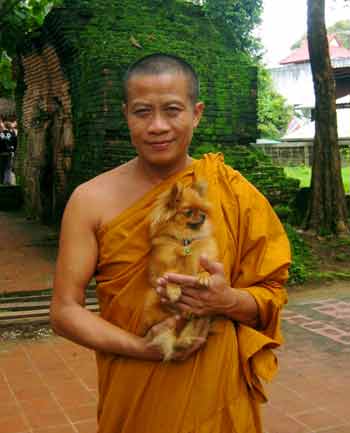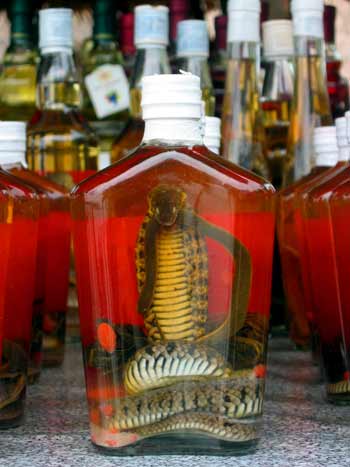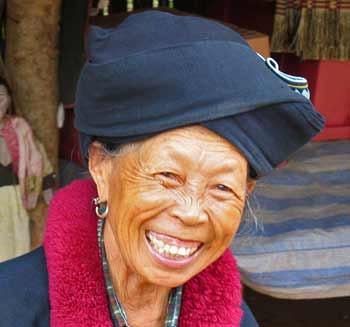The Golden Triangle
12th September, Chiang Mai, Thailand
A busy day and an early start - we had a lot of ground to cover today. The last couple of weeks we've been able to take things quite easy, so a 6am wake-up (for 7am departure) is a shock to the system. But it's still not as much of a shock as finding out that our driver was putting a little too much faith in the Buddha and none whatsoever in the Highway Code, if such a thing exists in Thailand (I suspect not). What can I say? This was some scary, erratic and downright dangerous driving. Overtaking was evidently too boring on a straight road, so we watched through gaps in our fingers as our driver hurled the Toyota Hiace round bends at 90km/h while overtaking another vehicle (or more) with no idea about what might be around the next bend. And even when he wasn't gambling with our lives on blind bends or at the peaks of hills, driving on a straight road presented its own fun: he seemed incapable of maintaining a consistent speed, so we would be sitting there feeling short bursts of accelleration followed by a brief lapse and then all over again.
Just as well we'd only be spending around 6 hours on the road then, eh?
The reason for the long day was this: we were heading up to the northernmost point of Thailand, through the Chiang Rai province. We could have made our way there under our own steam, but we thought it might be good to go on a tour, see what the place was like before heading up there ourselves for any length of time (or not head up there, if we decide that one day is enough).
Our first stop of the day was at some hot springs, the location of which escapes me because I'd just woken from an almost-slumber (it seemed the best tactic for not scaring myself silly with the crazy driving). There were just three open pools at the site, and had we felt like an egg for breakfast, we could have bought some quail eggs, dunked them in the almost boiling (90 degrees celsius) water and eaten them with a coating of soy sauce. In the end, though, we spent just a short while looking at the pools. They were fairly sad-looking and had nothing in common with the very natural surroundings of the hot springs we'd seen in Rotorua and Wai-O-Tapu in New Zealand; the only thing they had in common was that eggy, sulphurous smell.
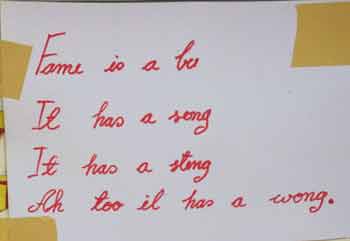
This sign - spotted at a stall near the hot springs
- is typical of the kind of signs you see around Thailand. Can anyone explain
what this means?
- Fame is a ba
- It has a song
- It has a stong
- Ah too il has a wong.
And I haven't a clue!
Onwards and upwards: next stop, Wat Chedi Luang. But we went there before, didn't we? Well, no ... actually, we visited a Wat Chedi Luang in Chiang Mai, but this one was just over an hour north of Chiang Mai in a place called Chiang Saen. This Chedi was much more antiquated, in a great state of decorative ruin (there's something really special about seeing these old structures being taken over by nature: moss, vines, tree roots etc). A perfect photo opportunuity arose when a monk appeared carrying a dog that was, by Thailand's standards, a prize specimen. He had all his legs, a complete covering of fur and a pair of bright gleaming eyes. The dog, not the monk, that is.
Ay Chihuahua!
We carried on for almost two hours, two more scary, death-defying hours, until we reached The Golden Triangle. This is the area where the borders of Thailand, Laos and Burma (or Myanmar as they like to call themselves these days) meet at the Mekong River. It was once known for its widespread opium cultivation, and indeed there is still opium harvested further back in Laos and Burma, but in Thailand it's been illegal since 1959. Of course, if you were to venture in to the right hill tribe village, you could find it, but from Thailand's side, the Golden Triangle is a tourist trap.
We took a boat ride out along the Mekong River as the guide pointed out Burma and Laos. This is how it went: engine at full pelt, engine stops, man at back of boat says: "Burma", we wait a few moments and then he starts the engine again, heads back down river a bit and says, "Laos." As you can see, all very enlightening! One of the funniest things to note was the casino. Firstly, the location tickled me, because gambling is illegal in Thailand, and there, across the water, the very first thing that you can see of Burma, is a casino! I noticed that outside the casino flew the flags of many different nations, including the Union Flag (UK). No matter how much those nations might denounce the Burmese, the Burmese in that joint didn't care: "We'll take anyone's money" it seemed to say.
We took a brief stop in Laos. No need for a visa or anything, as we were stopping at a little area that the Laos authorities set aside for day-trippers like ourselves called Don Sao Island. They still took a 20 baht tax for the privilege. Once again, this was a total tourist trap - the first thing I noticed as we stepped up off the boat on to the jetty was a stall selling bottles of alcohol and large boxes of cigarettes. The drinks also included some pretty nasty-looking 'snake whiskey'. A couple of Italian guys who were on our tour tried it out and confirmed that it tasted every bit as strong as it looked:
Anyone for a spot of Snake Whiskey? This one has bite!
The whole purpose of this little island was to take your money. I caved in ... but only a little (sending a couple of postcards from there, complete with Laos stamps and postmarks). One of the Italian guys bought a carton of Marlboros. How much are they here, I asked? 200 Baht he said - for 10 packs! Let's do the maths. 200 Baht is roughly £2.30 for 10 packs of cigarettes. "The price of just one packet in Italy!" he exclaimed. "The same price as half of a packet in the UK'" I replied. It's no wonder that people bring back loads from countries like this to sell on. That £2.30 carton would be worth something like £50 in the UK.
We soon made our way back across the water and continued to a place called Mae Sai, a village that sits on the border crossing into Burma (sorry, I mean Myanmar). There was very little to see here. The markets nearby were like so many others in Thailand, and once you've seen the same items at ten different stalls already, there's little else to do other than try your best to ignore the children that follow you around begging for money; they are very insistent and will follow you for some distance before getting the message. Standing at the northernmost point of Thailand, looking over at Burma, it was difficult to see where the control was in 'border control' - youngsters seemed to be playing freely on the bridge that separated the two countries (who still like the odd bit of target practice along some of the contested border regions further south). Thankfully, we didn't spend too long at Mae Sai, making our way back south to see some hill tribes.
The last time Manda and I saw hilltribe people, we were sat on top of an elephant and telling them that we didn't want to buy their goods. This time, we weren't on top of an elephant, but we did have to fend away the youngsters in the first village (an Akha tribe) who were offering bracelets and other items that we have seen hundreds of times before. It is a bit of a quandry - we know that these people make very little money from agriculture, and if anyone should get a few baht for these goods, it seems that they are more worthy than a market trader in a city. However, there is always a sneaking suspicion that we might be harming the traditional way of life here (and I don't believe it has always been the tradition that a whole alley in a village of straw huts and mud floor has, for the want of a better word 'boutiques'). I mean, what if disaster struck and tourism died away? It happens - the day I left Egypt in 1997, terrorists struck and the effects in lost tourist dollar were felt for years to come. Even taking a photo in an Akha village does not come for free, but this actually made us feel more comfortable. Instead of just taking a photo of a local sneakily, I just paid a toothless old woman who apparantly doesn't own a make-up mirror to pose with Manda.
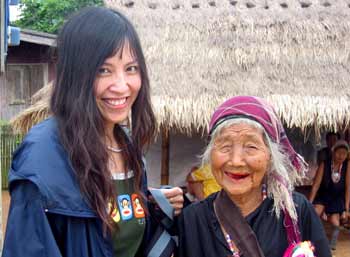
Nice lippy, love! Manda and an old lady from the Akha
tribe.
We also visited another tribe, this time Yao people, just a short distance away. We were told that these people would not ask any money for photos, and almost straight away we managed to snap this lovely smiling lady who laughed at everything, anything and garbled on in whatever language she was speaking, unperturbed by the fact that we didn't have a clue what she was saying:
Yep, she was a smiler alright, this Yao woman!
Even though we didn't have to pay for the photo, Manda felt obliged to buy something from this lady's stall. Then began some of the funniest scenes as Manda tried to find out how much one of the souvenirs cost with the crazy, unintelligable, laughing woman. As always, though, the communication problems were resolved with the aid of a calculator, as Manda and the smiler took turns typing figures into the calculator until a compromise was reached and both of them were smiling.
It had been a busy day, but it was not over just yet - we still had Death Race 2004 (part 2) to endure, and this time we had the added extra complication of torrential rain and a driver who only felt that the wipers should ever be used on 'intermitent' setting. Would our driver not spot a car coming in the opposite direction with its headlights off (a car that would be in the correct lane, I should clarify, with us most likely doing 100km/h on a bend)? Well, you're reading this post, so you know the answer to that. There were some close calls, though ... very close. And we still have Bangkok to experience!
